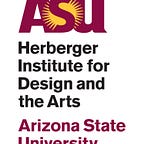Spotlight on alumni and other Herberger Institute highlights from February 2021
Everything is possible
“He didn’t accept ‘no.’ He didn’t accept when people said, ‘you can’t do that.’ And we want our students to feel that same sense of everything is possible.”
Earlier this month, ABC15 Arizona featured a story about the naming of The Sidney Poitier New American Film School, including interviews with Herberger Institute Dean Steven Tepper and film student Autumn Billie. Sir Sidney Poitier celebrated his 94th birthday on Feb. 20.
Making an impact
Stormy Nesbit, a Phoenix artist and designer who earned a master’s degree in visual communication design from The Design School, partnered with Forever 21 on a clothing line celebrating Black History Month.
“It’s touching when I get messages from people saying that their child was teased for their hair or their skin color, but now they have clothing that looks like them that they can wear with confidence.”
Sounding like tomorrow
The Washington Post named JiJi Kim, assistant professor in the School of Music, Dance and Theatre, to its first-ever Class of 21 for ’21: Composers and performers who sound like tomorrow.
Flying high-tech
Dylan Kerr, a student earning a master’s degree in digital culture (art) in ASU’s School of Arts, Media and Engineering, teamed up with airmen from Luke Air Force Base to develop a 3D augmented reality system that could revolutionize the way U.S. Air Force pilots train for combat.
Spotlight on alumni
ASU alums Merryn Alaka and Sam Fresquez both graduated from the Herberger Institute’s School of Art in May of 2019, Alaka with a bachelor’s degree in printmaking and Fresquez with a bachelor’s degree in intermedia. Their collaboration “It’s Mine, I Bought It” addresses, among other things, the assumptions about personal appearance that Black and Latina women contend with in white spaces. “It’s Mine, I Bought It” was installed most recently at Phoenix’s prestigious Lisa Sette Gallery, as part of the group show “Blue.” “It’s Mine, I Bought It” is just one of the pieces they have worked on together since forging a friendship in college.
By the numbers
This month’s number is 2,000! How long do you think it would take to merge two cars into one? For her “Bodywork” project, School of Art Associate Professor Liz Cohen spent about 2,000 hours of labor transforming an American El Camino and an East German car into a lowrider, while simultaneously transforming her own body to become a bikini model for her car at lowrider shows. The project examines her in-betweenness as a first-generation Latina and a child of the Cold War, with Colombian parents who tended to favor Warsaw Pact countries over Disneyland for summer vacations. It was also an avenue for Cohen to explore her own femininity and create dialogue around issues relating to immigration, nonconformity and resistance. You can see the car in ASU Art Museum’s “Body/Magic: Liz Cohen” exhibition, which brings together for the first time all aspects of Cohen’s “Bodywork” series. In a recent interview with KJZZ, Cohen talked about the car and lowrider culture, her art and the exhibition.
In pictures
In an effort to remember that we are one university, ASU invited artists to campus to contribute chalk art that shows support for the ASU community. Chalk artist Eli Farias got some help on his artwork from second year architecture student Vidal Duarte.
